#Addie Mae Collins
Photo

Dudley Randall, Ballad of Birmingham, Designed by Shirley Woodson, Broadside No. 1, Broadside Press, Detroit, MI, 1965 ['Broadside Press: Poetry to the People', Collection of the Smithsonian National Museum of African American History and Culture, Smithsonian Institution, Washington, DC. © Dudley Randall Literary Estate/Rare Book & Manuscript Library, University of Illinois at Urbana-Champaign]
#graphic design#poetry#broadside#dudley randall#shirley woodson#carole robertson#addie mae collins#cynthia wesley#denise mcnair#broadside press#national museum of african american history and culture#smithsonian institution#university of illinois rare book & manuscript library#1960s
21 notes
·
View notes
Text
Sixteenth Street Baptist Church In Birmingham Alabama Prepares For The 60th Anniversary Of The Youth Day Church Bombing
The Devastating AfterMath Of The Church Bombing
The young girls were killed and over 20 others were injured in the church explosion at 10:22 a.m. That Sunday morning in Birmingham, the innocence of youth was shattered as the children prepared for the church’s “Youth Day.” The world mourned alongside the 8,000 people who attended the funeral. Riots that erupted in the aftermath of the church…
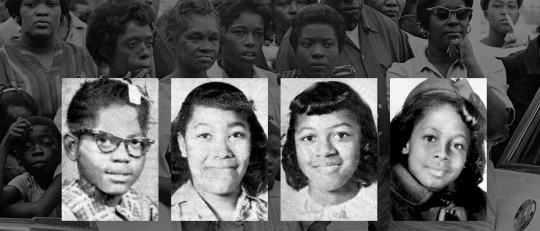
View On WordPress
#16th Street Baptist Church Bombing#60th Anniversary#Addie Mae Collins#Birmingham Alabama#Breaking News#Carole Robertson#Cynthia Wesley#Latest#September 15th 1963#Trending#Trending News
4 notes
·
View notes
Text
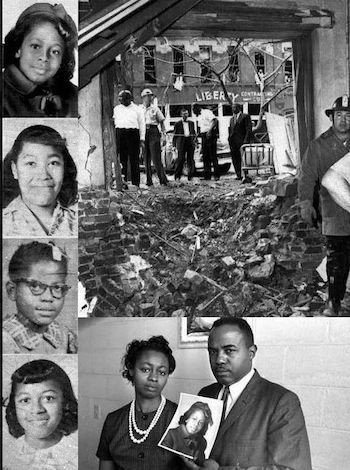
#black history#black history is american history#civil rights#black tumblr#black literature#black excellence#civil rights movement#black community#black girl magic#addie mae collins#denise mcnair#carole robertson#cynthia wesley#rest in peace#spike lee#black cinema#birmingham#racists#racism
27 notes
·
View notes
Text
youtube
Rhiannon Giddens - Birmingham Sunday (Official Audio)
Rhiannon Giddens
The 16th Street Baptist was a large and prominent church located downtown, just blocks from Birmingham's commercial district and City Hall. Just before 11 o'clock on September 15, 1963, instead of rising to begin prayers, the congregation was knocked to the ground. As a bomb exploded under the steps of the church, they sought safety under the pews and shielded each other from falling debris.
National Park Service. 16th Street Baptist Church Bombing (1963)
#music#rhiannon giddens#Addie Mae Collins#Denise McNair#Carole Robertson#Cynthia Wesley#kkk#terrorism#Youtube
2 notes
·
View notes
Text
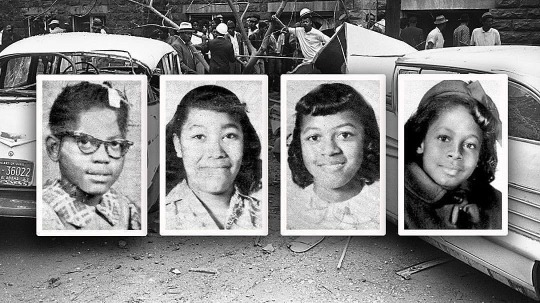
We will never forget the bombing at 16th Street Baptist Church in Birmingham, Alabama, on this date September 15, 1963.
From left to right:
Addie Mae Collins, 14.
Carole Robertson, 14.
Cynthia Wesley, 14.
Denise McNair 11.
A bomb planted by Ku Klux Klan members ripped through a Birmingham church, killing four little girls as they prepared for Sunday services.
The FBI determined that four members of a local KKK klavern known as the "Cahaba River Bridge Boys" were responsible for the bombing. The first prosecution didn't come until 1977. Then two more in the early 2000s. The fourth killer died, never being brought to account.
CARTER™️ Magazine carter-mag.com #wherehistoryandhiphopmeet #historyandhiphop365 #cartermagazine #carter #blackhistorymonth #blackhistory #history #staywoke #16thstreetbaptistchurch #saytheirnames
#carter magazine#carter#historyandhiphop365#wherehistoryandhiphopmeet#history#cartermagazine#today in history#staywoke#blackhistory#blackhistorymonth
177 notes
·
View notes
Text
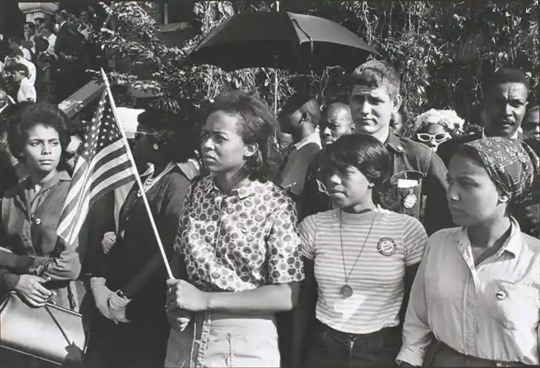
Danny Lyon Civil Rights Activists and Student Nonviolent Coordinating Committee Members (from left) Emma Bell, Dorie Ladner, Dona Richards, Sam Shirah, and Doris Derby at the Funeral of the Three of the Four Young Girls, Addie Mae Collins (age 14), Cynthia Wesley (14) and Carol Denise McNair (11) Killed in the KKK Bombing of the 16th St Baptist Church, Birmingham, AL 1963
47 notes
·
View notes
Text
60 years ago today, a bomb exploded during Sunday morning services in the 16th Street Baptist Church in Birmingham, Alabama, killing four young girls: Addie Mae Collins (14), Cynthia Wesley (14), Carole Robertson (14) and Carol Denise McNair (11).

23 notes
·
View notes
Text
The Birmingham Church Bombing Occurred in Alabama, Killing four young Black Girls. September 15, 1963.
Image: The four girls killed in the bombing (clockwise from top left) Addie Mae Collins (14), Cynthia Wesley (14), Carole Robertson (14), and Carol Denise McNair (11). (Wikimedia Commons.)
On this day in history, September 15, 1963, the Birmingham Church bombing occurred when an explosive device detonated prior to Sunday morning services at the 16th Street Baptist Church in Birmingham, Alabama –…

View On WordPress
18 notes
·
View notes
Text
The Unofficial Black History Book
The 16th Street Baptist Bombing (September 15th, 1963)

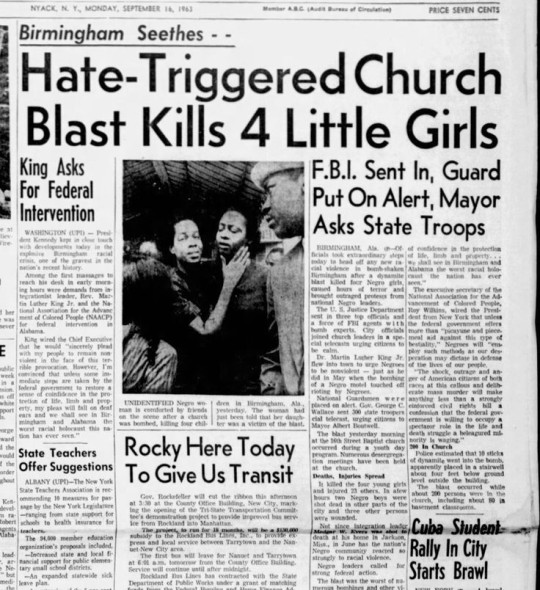


In the 1960s, Racial tension was at an all-time high. Many African Americans were doing their part in the fight for equal rights. A fight that claimed many innocent black lives.
Even the lives of four little girls.
This is the story.
The 16th Street Baptist Church was organized in 1873 as the first colored Baptist church in Birmingham, Alabama.
Many civil rights protest marches took place on the steps of the 16th Street Baptist Church. It has long been a significant religious center for the Black population and was a meeting place for civil rights organizers such as Dr. Martin Luther King Jr.
In the 1960s, Birmingham, Alabama, was one of America's most racially discriminatory and segregated cities and had one of the strongest and most violent chapters of the KKK. The city's police commissioner, Eugene "Bull" Connor, was known for his willingness to use brutality in combating radical union members, demonstrators, and innocent black citizens. Alabama's governor, George Wallace, was the leading opponent of desegregation.
By 1963, homemade bombs being set off in black homes and churches were such common occurrences that the city was given the nickname “Bombingham."
On September 15th, 1963, at 10:22 a.m., some 200 church members were in the building; most were attending Sunday school classes before the 11 a.m. service that morning.
A dynamite bomb was set off in the back stairwell, and mortar and bricks were thrown from the front of the church, caving in its walls. The violent blast ripped through the wall, killing four young African-American girls and injuring more than 20 others.
14-year-old Addie Mae Collins, 14-year-old Denise McNair, 14-year-old Carole Robertson, and 11-year-old Cynthia Wesley were in the basement of the church's ladies' restroom when they were crushed by the rubble.
Addie's sister, Sarah Collins, survived but lost her right eye.
The bombing of 16th Street Baptist Church was the third bombing in 11 days after a federal court order mandated the integration of Alabama's school system.
Upon learning of the attack, Reverend Martin Luther King Jr. sent a telegram to Alabama Governor George Wallace. He stated bluntly: "The blood of our little children is on your hands."
In the aftermath of the bombing, thousands of angry black protesters gathered at the scene of the bombing that same evening, and violence broke out across the city. Governor Wallace sent police and state troopers to break up the protesters. A handful of protesters were arrested, and two African-American youths were killed.
One at the hands of the police. And the other was murdered by a mob of white men.
This all happened before the National Guard was called to restore order.
The deaths of the four girls and the brutal attack shocked the nation and drew international attention to the violent struggle for civil rights in Birmingham.
Many whites were as outraged by the bombing as blacks and offered condolences to the families.
Over 8,000 people attended the girls' funeral services at Reverend John Porter's Sixth Avenue Baptist Church. The family of the fourth held a smaller private service. Dr. King spoke before the 8,000 people at the service.
It was a clear act of racial hatred, -- as the church was a key Civil Rights meeting place and had been a frequent target of bomb threats. KKK members routinely called in bomb threats intended to disrupt civil rights meetings and services.
In the investigation of the bombing, many of Birmingham's white supremacists and even certain individuals were immediately suspected. Repeated calls for the perpetrators to be brought to justice went unanswered for more than a decade.
It was revealed later that the FBI had information concerning the identity of the bombers in 1965 but did nothing.
The head of the FBI at the time was J. Edgar Hoover. He disapproved of the civil rights movement. It was rumored and claimed that Hoover held back evidence from prosecutors and even tried to block prosecution. He later died in 1972.
In 1977, Alabama Attorney General Bob Baxley reopened the investigation.
Klan leader Robert E. Chambliss was brought to trial for the bombings and was convicted of murder. He died in prison in 1985, still maintaining his innocence.
Later in 1980, 1988, and 1997, the case reopened again when two other former Klan members, Thomas Blanton, and Bobby Frank Cherry, were finally brought to trial. Blanton was convicted in 2001, and Cherry in 2002.
A fourth suspect, Herman Frank Cash, died in 1994 before he could be brought to trial.
The legal system was slow to provide justice, but the effect of the bombing was immediate and significant.
The outrage over the deaths of the four young girls helped build support for the struggle to end segregation. Support that would lead to the passage of both the Civil Rights Act of 1964 and the Voting Rights Act of 1965.
But even so, it couldn't bring back four young lives that were lost in an act of hatred.
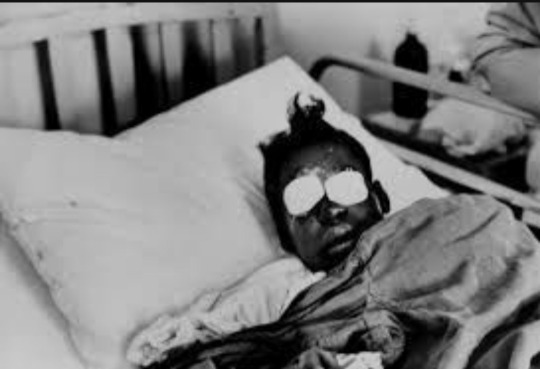
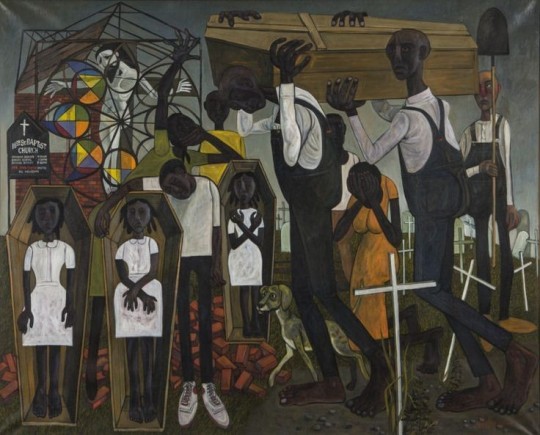
Painting: The 16th Street Baptist Chruch, By Mack Stanley - Asheville Art Museum
Prev
Phillis Wheatley
Next
Janet Collins
_____
My Resources
#black history matters#black history 365#black history is american history#black culture#black history#black tumblr#black lives fucking matter#protect black children#protect black lives#know your history#hate crimes#black stories#civil rights#learn your roots#black activism#protect black girls#civil rights movement#discrimination#history#social justice#cruel and unjust#the unofficial black history book#black female writers#say her name
11 notes
·
View notes
Text
CHRONOLOGY OF AMERICAN RACE RIOTS AND RACIAL VIOLENCE p-5
1961
May First Freedom Ride.
1962
Harlem Youth Opportunities Unlimited (HARYOU) is founded.
Robert F. Williams publishes Negroes with Guns, exploring Williams’ philosophy of black self-defense.
October Two die in riots when President John F. Kennedy sends troops to Oxford,Mississippi, to allow James Meredith to become the first African American student to register for classes at the University of Mississippi.
1963
Publication of The Fire Next Time by James Baldwin.
Revolutionary Action Movement (RAM) is founded.
April Rev. Martin Luther King, Jr., writes his ‘‘Letter from Birmingham Jail.’’
June Civil rights leader Medgar Evers is assassinated in Mississippi.
August March on Washington; Rev. King delivers his ‘‘I Have a Dream’’ speech before the Lincoln Memorial in Washington, D.C.
September Four African American girls—Carol Denise McNair, Cynthia Wesley, Carole Robertson, and Addie Mae Collins—are killed when a bomb explodes at theSixteenth Street Baptist Church in Birmingham, Alabama.
1964
June–August Three Freedom Summer activists—James Earl Chaney, Andrew Goodman, and Michael Schwerner—are arrested in Philadelphia, Mississippi; their bodies are discovered six weeks later; white resistance to Freedom Summer activities leads
to six deaths, numerous injuries and arrests, and property damage acrossMississippi.
July President Lyndon Johnson signs the Civil Rights Act.
New York City (Harlem) riot.
Rochester, New York, riot.
Brooklyn, New York, riot.
August Riots in Jersey City, Paterson, and Elizabeth, New Jersey.
Chicago, Illinois, riot.
Philadelphia, Pennsylvania, riot.
1965
February While participating in a civil rights march from Selma to Montgomery, Alabama,
Jimmie Lee Jackson is shot by an Alabama state trooper.
Malcolm X is assassinated while speaking in New York City.
March Bloody Sunday march ends with civil rights marchers attacked and beaten by local lawmen at the Edmund Pettus Bridge outside Selma, Alabama.
Lowndes County Freedom Organization (LCFO) is formed in Lowndes County,Alabama.
First distribution of The Negro Family: The Case for National Action, better known as The Moynihan Report, which was written by Undersecretary of Labor Daniel Patrick Moynihan and Nathan Glazer.
July Springfield, Massachusetts, riot.
August Los Angeles (Watts), California, riot.
1965–1967
A series of northern urban riots occurring during these years, including disorders in the Watts section of Los Angeles, California (1965), Newark, New Jersey (1967), and
Detroit, Michigan (1967), becomes known as the Long Hot Summer Riots.
1966
May Stokely Carmichael elected national director of the Student Nonviolent Coordinating Committee (SNCC).
June James Meredith is wounded by a sniper while walking from Memphis, Tennessee, to Jackson, Mississippi; Meredith’s March Against Fear is taken up by Martin Luther King, Jr., Stokely Carmichael, and others.
July Cleveland, Ohio, riot.
Murder of civil rights demonstrator Clarence Triggs in Bogalusa, Louisiana.
September Dayton, Ohio, riot.
San Francisco (Hunters Point), California, riot.
October Black Panther Party (BPP) founded by Huey P. Newton and Bobby Seale.
1967
Publication of Black Power: The Politics of Liberation by Stokely Carmichael and Charles V. Hamilton.
May Civil rights worker Benjamin Brown is shot in the back during a student protest in Jackson, Mississippi.
H. Rap Brown succeeds Stokely Carmichael as national director of the Student Nonviolent Coordinating Committee (SNCC).
Texas Southern University riot (Houston, Texas).
June Atlanta, Georgia, riot.
Buffalo, New York, riot.
Cincinnati, Ohio, riot.
Boston, Massachusetts, riot.
July Detroit, Michigan, riot.
Newark, New Jersey, riot.
1968
Publication of Soul on Ice by Eldridge Cleaver.
February During the so-called Orangeburg, South Carolina Massacre, three black college students are killed and twenty-seven others are injured in a confrontation with police on the adjoining campuses of South Carolina State College and Claflin College.
March Kerner Commission Report is published.
April Dr. Martin Luther King, Jr., is assassinated in Memphis, Tennessee.
President Lyndon Johnson signs the Civil Rights Act of 1968.
Washington, D.C., riot.
Cincinnati, Ohio, riot.
August Antiwar protestors disrupt the Democratic National Convention in Chicago.
1969
May James Forman of the SNCC reads his Black Manifesto, which calls for monetary reparations for the crime of slavery, to the congregation of Riverside Church in New York; many in the congregation walk out in protest.
July York, Pennsylvania, riot.
1970
May Two unarmed black students are shot and killed by police attempting to control civil
rights demonstrators at Jackson State University in Mississippi.
Augusta, Georgia, riot.
July New Bedford, Massachusetts, riot.
Asbury Park, New Jersey, riot.
1973
July So-called Dallas Disturbance results from community anger over the murder of a twelve-year-old Mexican-American boy by a Dallas police officer.
1975–1976
A series of antibusing riots rock Boston, Massachusetts, with the violence reaching a climax in April 1976.
1976
February Pensacola, Florida, riot.
1980
May Miami, Florida, riot.
1981
March Michael Donald, a black man, is beaten and murdered by Ku Klux Klan members in Mobile, Alabama.
1982
December Miami, Florida, riot.
1985
May Philadelphia police drop a bomb on MOVE headquarters, thereby starting a fire that consumed a city block.
1986
December Three black men are beaten and chased by a gang of white teenagers in Howard Beach, New York; one of the victims of the so-called Howard Beach Incident is killed while trying to flee from his attackers.
1987
February–April Tampa, Florida, riots.
1989
Release of Spike Lee’s film, Do the Right Thing.
Representative John Conyers introduces the first reparations bill into Congress—the Commission to Study Reparation Proposals for African Americans Act; this and all subsequent reparations measures fail passage.
August Murder of Yusef Hawkins, an African American student killed by Italian-American youths in Bensonhurst, New York.
1991
March Shooting in Los Angeles of an African American girl, fifteen-year-old Latasha Harlins, by a Korean woman who accused the girl of stealing.
Los Angeles police officers are caught on videotape beating African American motorist Rodney King.
1992
April Los Angeles (Rodney King), California, riot.
1994
Survivors of the Rosewood, Florida, riot of 1923 receive reparations.
February Standing trial for a third time, Byron de la Beckwith is convicted of murdering civil rights worker Medgar Evers in June 1963.
18 notes
·
View notes
Text
youtube
Rhiannon Giddens singing “Birmingham Sunday” a song about the Ku Klux Klan’s bombing of the 16th Street Baptist Church in Birmingham, Alabama that killed four young girls—Addie Mae Collins (14), Cynthia Wesley (14), Carole Robertson (14), and Carol Denise McNair (11). This happened 60 years ago today on September 15, 1963.
_________________________
Birmingham Sunday
Songwriter: Richard Fariña
Come 'round by my side and I'll sing you a song
I'll sing it so softly it'll do no one wrong
On Birmingham Sunday the blood ran like wine
And the choir kept singing of freedom
That cold autumn morning no eyes saw the sun
And Addie Mae Collins, her number was one
In an old Baptist church there was no need to run
And the choir kept singing of freedom
The clouds, they were dark and the autumn wind blew
And Denise McNair brought the number to two
The falcon of death was a creature they knew
And the choir kept singing of freedom
The church, it was crowded and no one could see
That Cynthia Wesley's dark number was three
Her prayers and her feelings would shame you and me
And the choir kept singing of freedom
Young Carol Robertson entered the door
And the number her killers had given was four
She asked for a blessing, but asked for no more
And the choir kept singing of freedom
On Birmingham Sunday a noise shook the ground
And people all over the Earth turned around
For no one recalled a more cowardly sound
And the choir kept singing of freedom
The men in the forest, they once asked of me
How many black berries grow in the Blue Sea
I asked them right back with a tear in my eye
How many dark ships in the forest?
The Sunday has come, the Sunday has gone
And I can't do much more than to sing you a song
I'll sing it so softly it'll do no one wrong
And the choir keeps singing of freedom
7 notes
·
View notes
Photo

16th Street Baptist Church, Birmingham, AL, September 15, 1963
Addie Mae Collins (1949-1963)
Cynthia Wesley (1949-1963)
Denise McNair (1951-1963)
Carol Robertson (1949-1963)
(image: The 16th Street Baptist Church, seen from inside a destroyed car, on September 17, 1963, two days after the bombing. «Time». Matt Herron / Take Stock / The Image Works)
#photography#addie mae collins#cynthia wesley#denise mcnair#carol robertson#16th street baptist church#time#matt herron#1940s#1950s#1960s
31 notes
·
View notes
Text
LETTERS FROM AN AMERICAN
September 15, 2023 (Friday)
HEATHER COX RICHARDSON
At 10:22 this morning, a Jewish temple in Birmingham, Alabama, blew the shofar, and churches rang their bells four times.
It was at that moment, sixty years ago, that a bomb ripped through the 16th Street Baptist Church in Birmingham, Alabama. It was Youth Day in the historic brick church on Sunday, September 15, 1963, and five young girls dressed in their Sunday best were in the ladies’ lounge getting ready for their part in the Sunday service that was about to start. As Denise McNair, Cynthia Wesley, Carole Robertson, and Addie Mae Collins were chatting and adjusting their dresses, a charge of dynamite stashed under the steps that led to the church sanctuary blasted into the ladies lounge, killing the four girls instantly. Standing at the sink in the back of the room, Addie’s sister Sarah survived with serious injuries.
Just five days before, Black children had entered formerly all-white schools after an August court order required an end to segregation in Birmingham’s public schools. This decision capped a fight over integration that had begun just after the May 1954 Brown v. Board of Education decision in which the Supreme Court declared segregation unconstitutional.
In that same year, in the wake of the successful 381-day Montgomery, Alabama, bus boycott to protest that city’s segregated bus system, Birmingham’s Reverend Fred Shuttlesworth, along with the Reverend Martin Luther King Jr., the Reverend Ralph Abernathy, and strategist and civil rights activist Bayard Rustin, started the Southern Christian Leadership Conference (SCLC) to challenge segregation through nonviolent protest, rather than trusting the work to the courts alone.
[.....]
The death of innocent children—on a Sunday morning, in a house of God—at the hands of white supremacists drew national attention. It woke up white people who had previously been leery of civil rights protests, making them confront the horror of racial violence in the South. Support for civil rights legislation grew, and in 1964 that support helped legislators to pass the Civil Rights Act.
Still, it seemed as if the individual bombers would get away with their crimes. In 1968, the FBI investigation ended without indictments.
But it turned out the story wasn’t over. Bill Baxley, a young law student at the University of Alabama in 1963, was so profoundly outraged by the bombing that he vowed someday he would do something about it. In 1970, voters elected Baxley to be Alabama’s attorney general. He reopened the case, famously responding to a Ku Klux Klan threat by responding on official state letterhead: “kiss my *ss.”
The reluctance of the FBI to share its evidence meant that Baxley charged and convicted only Robert Chambliss—whose nickname in 1963 was “Dynamite Bob”—for the murder of Denise McNair.
But still the story wasn’t over. Another young lawyer named Doug Jones was in the courtroom during that trial, and in 1997, President Bill Clinton appointed Jones as U.S. attorney for the Northern District of Alabama. Jones pursued the case, uncovering old evidence and finding new witnesses. Herman Cash had died, but in 2001 and 2002, representing the state of Alabama, Jones successfully prosecuted Thomas Edwin Blanton and Bobby Frank Cherry for first-degree murder.
Chambliss, Cherry, and Blanton all died in prison: Chambliss in 1985, Cherry in 2004. Blanton died in 2020.
—
LETTERS FROM AN AMERICAN
HEATHER COX RICHARDSON
#Letters from an American#Heather Cox Richardson#Alabama#history#racism#KKK#MLK Jr.#Bull Connor#segregation#integration
5 notes
·
View notes
Text

Victims of White racist terrorists. The 16th Street Church bombing. This act of terror took the lives of Addie Mae Collins 14, Carol Denise McNair 11, Carole Rosamond Robertson 14, and Cynthia Dionne Wesley 14. The bombing was committed by the United Klans of America. Like the other coward, Dylan Roof, they seem to enjoy killing Blacks in churches. Since BLM is the “new” Klan I’ll wait for someone to show me ONE White church they’ve BOMBED and four little White girls they MURDERED. Shouldn’t be too hard to find.
18 notes
·
View notes
Text
Sad like 1963
I've been sad reading social media posts in response to police beating Tyre Nichols to death. So many of us are experiencing a profound sense of grief.
This morning I saw a post by a dad who said his biggest worry is for his eight-year old son, that one day some cop will 'fear for his Life' and "murder my boy.” He went on to tell about his son. Children that age are so lovely and hearing this man speak of his son made it impossible not to adore his child.
I was seven-years old in 1963. And for reasons I am not sure in grieving Tyre Nichols my memories turned to events that year from the perspective of being little then. TV was new to our house, we'd only had one for a year or so. The pictures I remember are from TV.
In April Dr. Martin Luther King, Jr. was jailed in Birmingham, Alabama were he wrote a famous letter from his jail cell. I didn't read the letter as a boy but I do suspect I heard his name. On May 2nd children who'd been trained in non-violent tactics marched. Hundreds were arrested. "By the second day, Commissioner of Public Safety Bull Connor ordered police to spray the children with powerful water hoses, hit them with batons and threaten them with police dogs."
The images I saw on TV stunned me, they made me feel sad and worried. I had a sense that I wasn't the only one feeling so. I have seen photographs many times over the years, but the picture that comes to mind is very close to one in the entry on photographer Charles Moore at Wikipedia.
On August 28, 1963 Dr. King gave his "I Have a Dream" speech. I can't place memories of watching coverage of the March on Washington. However I do remember loving to sing "If I Had a Hammer," one of the songs Peter Paul and Mary sang that day. My favorite part was: "It's the song account love between/ My brothers and my sisters/ All over this land." I have brothers and sisters, but I felt sure that this song extended beyond my home. Thar's the part which seemed so exciting!
On September 15th the 16th Street Baptist Church was bombed by a group of KKK members. Twenty-two church goers were injured and four girls were killed in the explosion. Childhood memories can be a bit suspect, nevertheless what I remember is hearing the children’s names read by the TV anchor: Addie Mae Collins, Cynthia Wesley, Carole Robertson and Carol Denise McNair.
President Kennedy was assassinated on November 22, 1963 in Dallas, Texas. My brother is four years younger and was deeply affected by watching President Kennedy's funeral on TV. I was probably at school Anyhow the picture that come to mind first is seeing Jack Ruby shooting Lee Harvey Oswald.
Grief moves through us. That dad worried for his son knows it. I feel sure his son feels some measure of grief over the violent death of Tyre Nichols too. In grief's wake we are changed. The traumatic events of 1963 were shared widely. The protest in Birmingham forced concessions from city leaders and business desegregated. In February of 1964 the Civil Rights Act was signed. The KKK didn't surrender, of course, and the struggle continues to this day. The song about love between my brothers and sisters inspired hope in me and still does. That inspiration to love was shared too. We are not powerless we can dream and create better lives for all.
#tyre nichols#grief#civil rights struggle#struggle continues#faith#a better worls is possible#children#1963
8 notes
·
View notes
Photo

We will never forget the bombing at the 16th Street Baptist Church in Birmingham, Alabama, on this date September 15, 1963. From left to right: Addie Mae Collins, 14. Carole Robertson, 14. Cynthia Wesley, 14. Denise McNair 11. CARTER™️ Magazine carter-mag.com #wherehistoryandhiphopmeet #historyandhiphop365 #cartermagazine #carter #blackhistorymonth #blackhistory #history #staywoke #16thstreetbaptistchurch #saytheirnames https://www.instagram.com/p/CihV7joOUOf/?igshid=NGJjMDIxMWI=
#wherehistoryandhiphopmeet#historyandhiphop365#cartermagazine#carter#blackhistorymonth#blackhistory#history#staywoke#16thstreetbaptistchurch#saytheirnames
59 notes
·
View notes